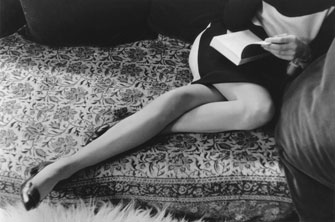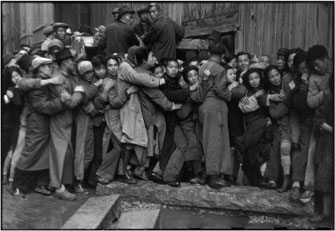Beyond the Decisive Moment,
Multiple Cartier-Bressons

“Martine Franck, Paris, France” (1967). © Henri Cartier-Bresson/Magnum Photos, courtesy Fondation Henri Cartier-Bresson
Henri Cartier-Bresson, wealthy bourgeois, Surrealist, leftist, portraitist and father of photojournalism, was unequivocally one of the great photographers of the last century. A retrospective show at the Centre Pompidou spans his whole career in all its complexity, illustrating the range and depth of his work from 1926 until 1970.
It is a monumental exhibition, tracing his development chronologically through more than 350 photographs, films, documents and other archival materials. The aim is to show that there were several Cartier-Bressons – not just the photographer who invented the idea of “the decisive moment” and created the famed Magnum agency with his equally iconic photographer friends Robert Capa and David Seymour, a.k.a. Chim.
The exhibition follows his progress through the turbulent years of the mid-20th century and also offers an account of the century as seen through his eyes. In his early years as a pupil of the artist Andre Lhote, Cartier-Bresson learned the classic rules of geometry and composition. In the late 1920s, he hung out with the Surrealists, absorbing certain signature motifs – deformed bodies, wrapped objects and dreamers with closed eyes.
Political engagement filled the years 1936-46 as the photographer worked for Communist newspapers and in cinema and enlisted when war broke out. He was captured, escaped and joined the Resistance, and filmed the returning prisoners of war and refugees when the war ended. In 1947 came the founding of Magnum. The agency sent him to Asia, where he won international acclaim with his pictures of

Crowd waiting outside a bank to purchase gold during the last days of the Kuomintang, Shanghai, China, December 1948. © Henri Cartier-Bresson/Magnum Photos, courtesy Fondation Henri Cartier-Bresson
Ghandi’s funeral, the dying days of old China and the tortured birth of Mao’s new people’s paradise.
The exhibition offers a rare chance to see some of Cartier-Bresson’s lesser-known work, notably from his early years. It was during a voyage to Africa in 1930 that the desire to make a profession of photography crystallized in his mind. There followed five years of constant travel, to Berlin, Brussels, Prague, Warsaw and Budapest, then Spain, Mexico, and United States in the grip of the Great Depression. During this time, he scraped out a living by working for several publications.
For the exhibition’s curator, Clement Cheroux, there are “several Cartier Bressons: one who is close to the Surrealists, another who is a Communist, another who is a photojournalist and finally one who contemplates, and this obviously influences the way he takes a photograph.”
All of these several Cartier-Bressons are worth knowing better.
Centre Pompidou: 19, rue Beaubourg, 75004 Paris. Tel.: 01 44 78 12 33. Open 11am-9pm. Closed Tuesday. Métro: Rambuteau. Admission: €11-13. Through June 9, 2014. www.centrepompidou.fr
Reader reaction: Click here to respond to this article (your response may be published on this page and is subject to editing).
Please support Paris Update by ordering books from Paris Update’s Amazon store at no extra cost. Click on your preferred Amazon location: U.K., France, U.S.
More reviews of Paris art shows.
© 2014 Paris Update
Favorite